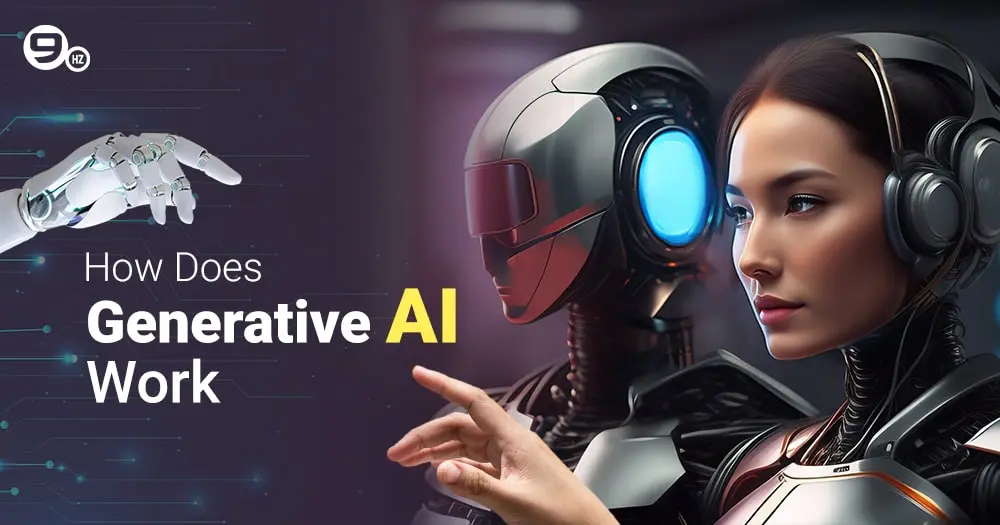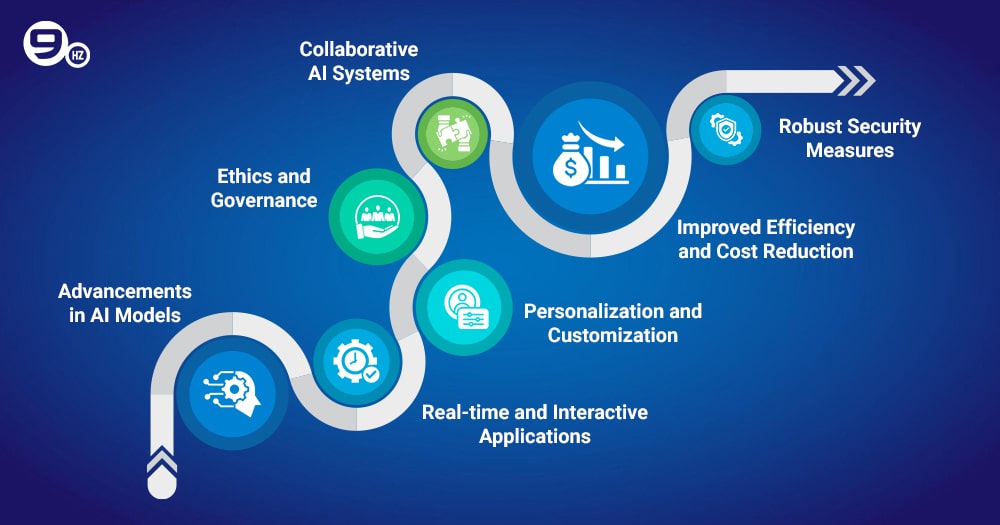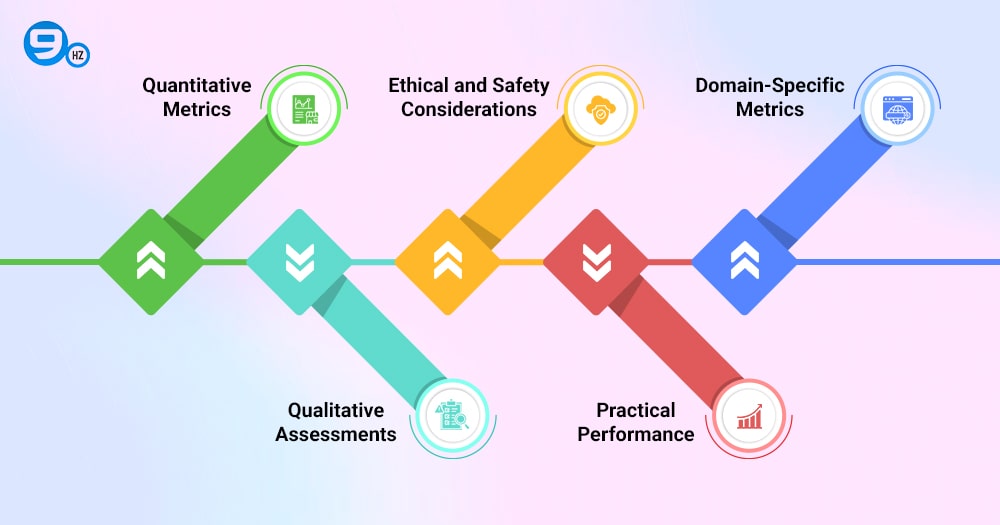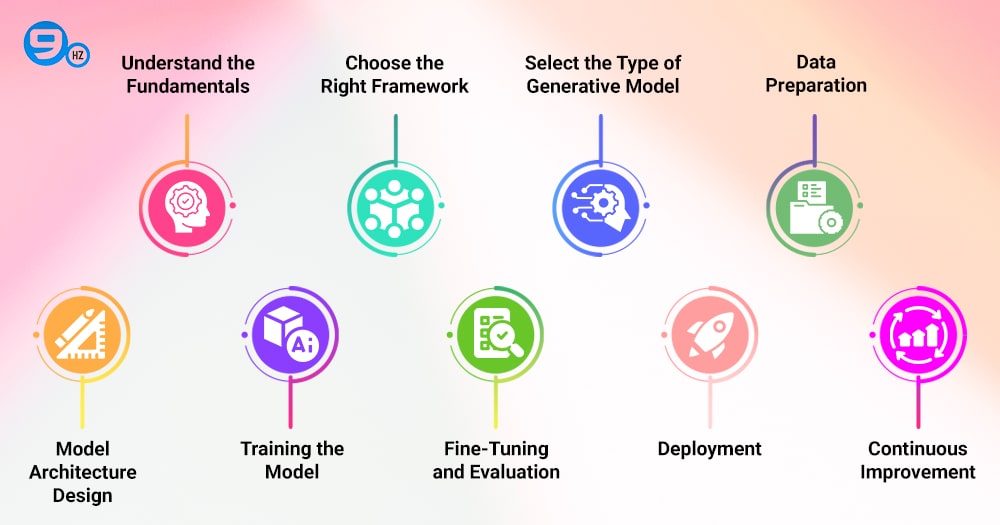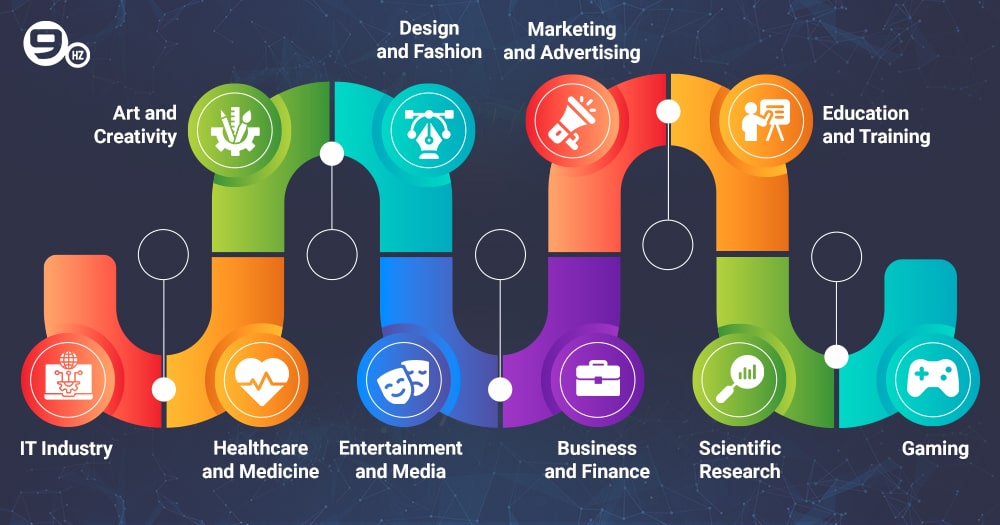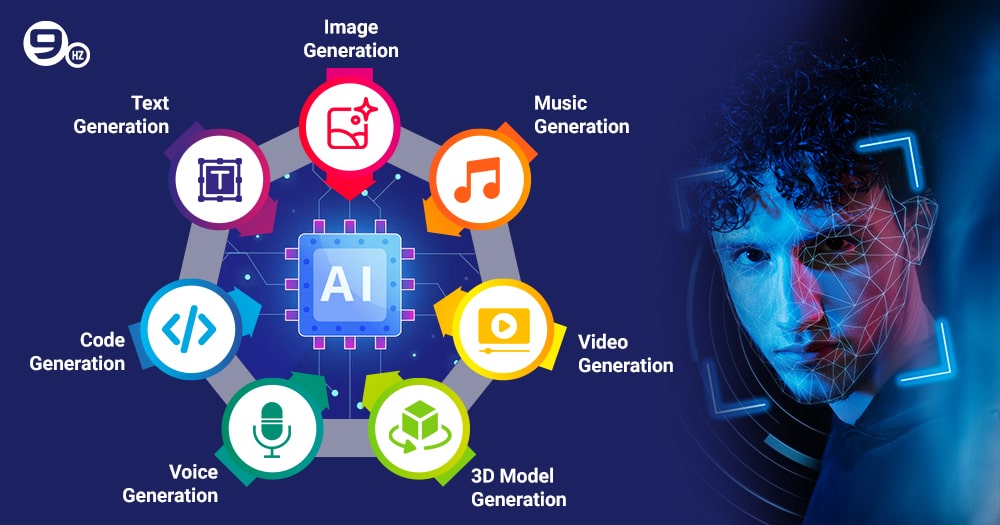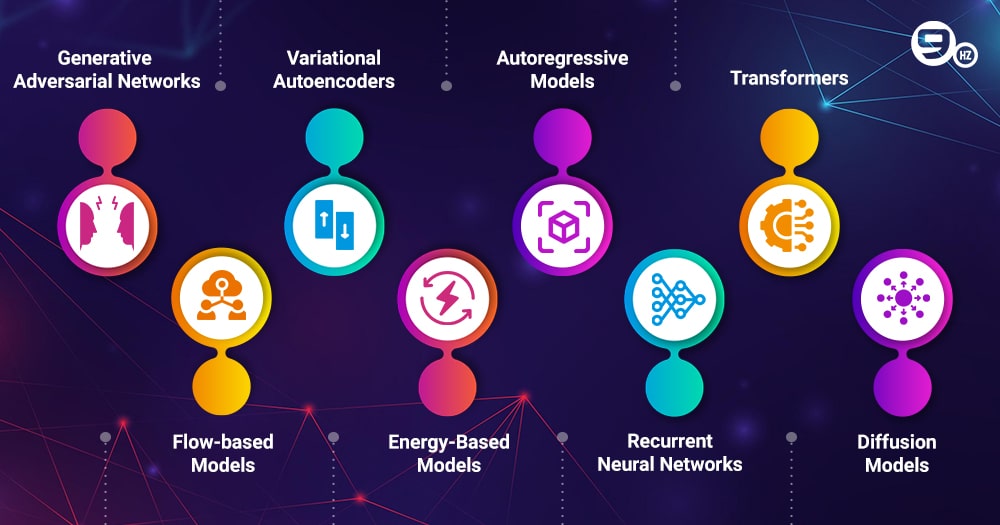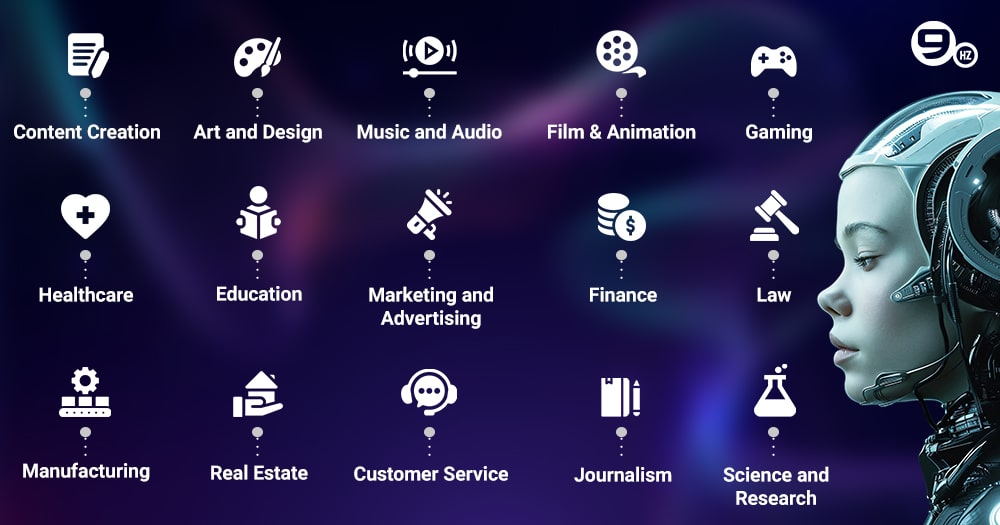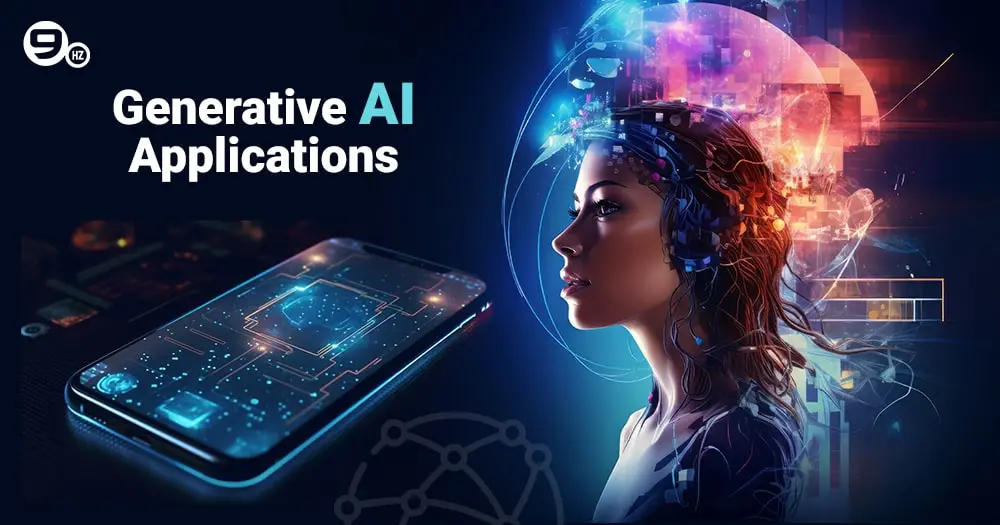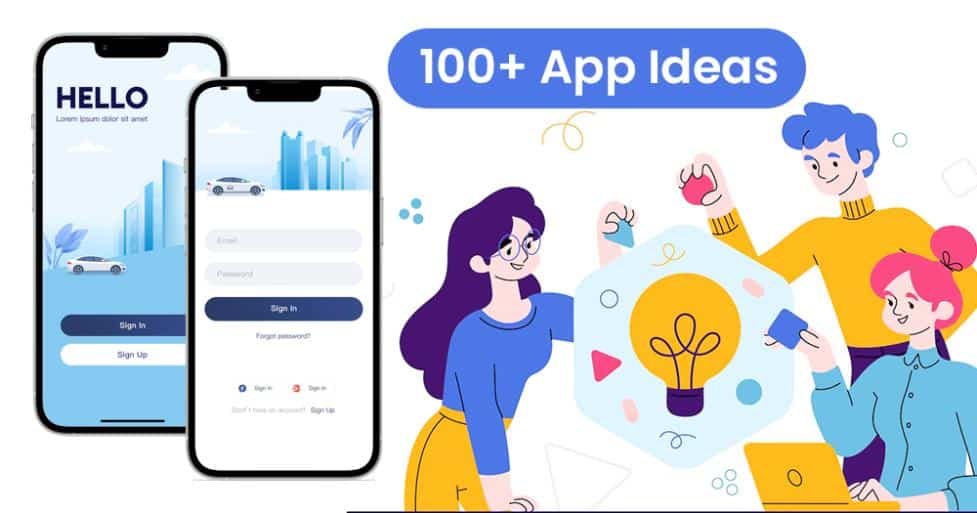Generative AI, an advanced branch of artificial general intelligence, is reshaping industries with its unique ability to create new, original content from text and images to music and beyond. How does generative AI work? The answer may appear simple, but a lot of technical work goes behind it. The first step in the process of generative AI is a prompt, which can be any input that the AI system can handle, such as a word, image, video, design, musical notation, or other type of input. After that, different AI algorithms respond to the instructions by returning fresh content.
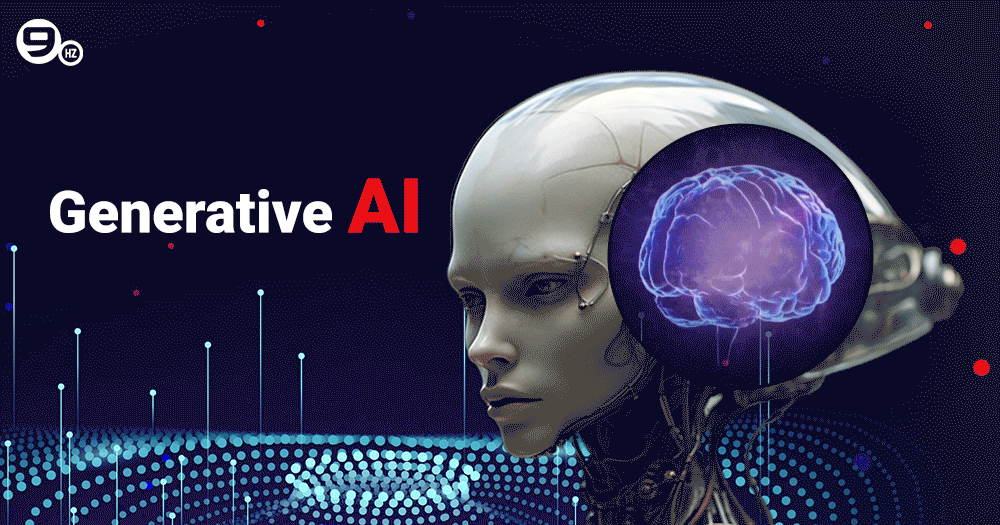
Generative AI is rapidly gaining traction and is projected to make a significant impact in the coming years. According to a report by Gartner, generative AI is expected to account for 10% of all data produced by 2025, a substantial increase from less than 1% today.
Furthermore, Markets and Markets forecasts that the generative AI market will skyrocket from $7.9 billion in 2022 to an astonishing $51.8 billion by 2028, underscoring its rapid adoption and immense potential. As we move into 2024, gaining a clear understanding will be crucial for responsibly and effectively harnessing its power.
How Does Generative AI Work?
The first step in the generative AI process is a prompt, which can be any input that the AI system can handle, such as a word, image, video, design, musical notation, or other type of input. After that, different AI algorithms respond to the instructions by returning fresh content. Content can include articles, problem-solving methods, and realistic fakes created from actual people’s photos or speech.
Data submission in the early stages of generative AI necessitated the usage of an API or other time-consuming processes. The developers at a generative AI development company had to pick up the skills necessary to write programs in languages like Python and operate specialist equipment.
These days, innovators in generative AI tools are creating better user interfaces that let you communicate a request in plain language. Following a first reaction, you can also add comments to the results to personalize them.
What is Generative AI?
Generative AI refers to a type of artificial intelligence system designed to create new, original content by learning patterns from existing data. Unlike traditional AI, which often focuses on tasks such as classification, prediction, or detection, generative AI is oriented towards producing new data that is similar to the data it was trained on. This can include generating text, images, audio, and other types of data.
The core idea behind generative AI is to learn the distribution of the training data so well that it can generate new instances that closely resemble the original dataset. This involves complex mathematical and statistical methods to capture the data’s characteristics, structures, and distinctions.
Large datasets are used to train models in generative AI, which helps the models discover patterns and relationships in the data. The parameters of the models are changed during training to reduce discrepancies between the produced output and the real data. Once trained, these models can create new information that is logical and appropriate for the environment; to human observers, it is frequently impossible to separate it from real data.
For those interested in exploring how to use artificial intelligence in mobile apps, generative AI offers a significant advantage. These apps can leverage generative AI to provide enhanced user experiences, from generating personalized content to creating unique artworks or music.
Considering everything, it can be said that generative AI is a big step forward for artificial intelligence, pushing the limits of what machines can produce and thus creating new opportunities for creativity and innovation in many fields.
Its Core Components
Data Input
Generative AI requires large datasets for training. These datasets can include anything from written texts and spoken language to visual images and music compositions. The quality and diversity of the input data significantly influence the model’s ability to generate realistic and diverse outputs.
1. Model Training: At the heart of generative AI are complex models like Generative Adversarial Networks (GANs) and Variational Autoencoders (VAEs). During the training phase, these models pick up on the fundamental structures and patterns found in the input data. This learning process involves extensive computation and fine-tuning of numerous parameters to achieve optimal performance.
2. Output Generation: Once trained, the model can produce new data that resembles the original input data. For example, a model trained on a vast corpus of text can generate coherent and contextually relevant sentences. Similarly, a model trained on a set of images can create visually plausible new images.
Future Trends in Generative AI
Generative AI has rapidly evolved, transforming various industries with its ability to create content, simulate environments, and enhance decision-making processes. As we look to the future, several key trends are expected to shape its trajectory
1. Advancements in AI Models
The development of more sophisticated and capable models is a continuous trend. Models like GPT-4 have already demonstrated significant improvements in language understanding and generation. Future models are expected to:
- Increase in scale and complexity: AI models will become larger and more complex, capable of understanding and generating more nuanced and contextually appropriate content.
- Enhanced multimodal capabilities: Future models will likely integrate various types of data, such as text, image, audio, and video, to create richer and more diverse outputs.
2. Real-time and Interactive Applications
The use of generative AI applications in real-time will increase and improve user interactions in various domains:
- Gaming and Virtual Reality: AI will create more engaging and responsive gaming environments, allowing for dynamic storytelling and flexible gameplay.
- Customer Service: Chatbots and virtual assistants will become more responsive and can handle complex queries, providing a more human-like interaction.
3. Personalization and Customization
Generative AI will enable highly personalized experiences, tailoring content to individual preferences and needs:
- Marketing and Advertising: AI will generate targeted advertising content that resonates more effectively with specific audiences.
- Education: Personalized learning experiences will be created, adapting to individual student needs and learning styles.
4. Ethics and Governance
As generative AI becomes more pervasive, ethical considerations and governance will play a critical role:
- Bias and Fairness: There will be a greater focus on reducing bias in AI models and making sure that the content generated by AI is fair.
- Regulation: Governments and organizations will establish frameworks and regulations to guide the ethical use of generative AI, addressing issues such as misinformation, privacy, and intellectual property rights.
5. Collaborative AI Systems
Future generative AI systems will increasingly work alongside humans, augmenting human capabilities:
- Creative Collaboration: Artists, writers, and designers will use AI as a collaborative tool to enhance creativity and productivity.
- Scientific Research: AI will assist researchers in generating hypotheses, designing experiments, and analyzing complex datasets, accelerating scientific discovery.
6. Improved Efficiency and Cost Reduction
Generative AI will drive efficiency and reduce costs in various industries:
- Content Creation: Automated content generation will streamline production processes in media, entertainment, and publishing.
- Manufacturing: AI-driven design and simulation will optimize manufacturing processes, reducing time and material costs.
7. Robust Security Measures
As the capabilities of generative AI expand, so will the need for robust security measures:
- Deepfake Detection: Advanced tools will be developed to detect and counteract deepfakes and other malicious uses of generative AI.
- Data Privacy: Enhanced encryption and privacy-preserving techniques will be implemented to protect sensitive data in best AI applications.
The future of generative AI is promising, with advancements poised to revolutionize various sectors. Understanding how does generative AI works is crucial in this context. Generative AI operates by learning patterns from vast amounts of data and using this knowledge to generate new, original content across different domains such as text, images, and music. This technology differs from traditional AI by focusing on creativity and the production of new data that closely resembles the training data it learned from.
As the technology continues to evolve, the ethical and regulatory challenges must be addressed to ensure that the development of generative AI benefits society as a whole. Embracing these trends will enable us to harness the full potential of generative AI, driving innovation and improving quality of life.
How to Evaluate Generative AI Models?
Evaluating generative AI models is a critical task to ensure they perform effectively and ethically. The evaluation process involves a combination of quantitative metrics, qualitative assessments, and ethical considerations. Here are key steps and methods to evaluate generative AI models:
1. Quantitative Metrics
These metrics provide numerical values that help compare the performance of different models objectively.
- Perplexity: Commonly used in language models, perplexity measures how well the model predicts a sample. Lower perplexity indicates a better model.
- BLEU (Bilingual Evaluation Understudy) Score: Used in machine translation, it evaluates the overlap between the generated text and reference translations. Higher BLEU scores indicate better performance.
- ROUGE (Recall-Oriented Understudy for Gisting Evaluation): Used for summarization tasks, it measures the overlap of n-grams between the generated summary and reference summaries.
- FID (Frechet Inception Distance): Used to evaluate the quality of images generated by GANs, it compares the statistics of generated images with real images. Lower FID scores indicate higher quality.
- Inception Score: Also used for image generation, it evaluates the diversity and quality of generated images based on the output of a pre-trained Inception model.
2. Qualitative Assessments
These involve subjective evaluation and human judgment to assess the quality and relevance of generated outputs.
- Human Evaluation: Involves having human evaluators rate the quality, coherence, and relevance of generated content. This can include surveys, A/B testing, and expert reviews.
- Turing Test: Named after Alan Turing, this test assesses whether the generated content is indistinguishable from human-created content.
- Content Analysis: Involves a detailed examination of generated content for attributes such as creativity, novelty, and adherence to desired styles or themes.
3. Ethical and Safety Considerations
These are crucial to ensure the responsible use of generative AI models.
- Bias and Fairness: Evaluating the model for biases in generated content, ensuring it does not propagate harmful stereotypes or unfair representations.
- Toxicity and Harmful Content: Assessing whether the model generates inappropriate, harmful, or offensive content, using tools like OpenAI’s GPT-3 content filter.
- Privacy: Ensuring the model does not inadvertently generate sensitive or private information.
- Explainability: Evaluating how transparent and understandable the model’s decision-making process is, which is essential for trust and accountability.
4. Practical Performance
These assessments focus on the model’s efficiency and usability in real-world applications.
- Latency and Speed: Measuring the time it takes for the model to generate content, which is crucial for user experience in interactive applications.
- Scalability: Evaluating how well the model performs as the size of the input data or the number of users scales up.
- Resource Efficiency: Assessing the computational resources required by the model, including memory and processing power.
5. Domain-Specific Metrics
Different applications may require specialized metrics tailored to the domain of the generated content.
- Relevance and Accuracy: For models generating domain-specific content (e.g., medical advice, financial reports), accuracy and relevance to the domain are critical.
- User Satisfaction: Gathering feedback from end-users to evaluate how well the model meets their needs and expectations in the practical applications.
A varied approach is needed to evaluate generative AI models that combine quantitative metrics, qualitative assessments, ethical considerations, and assessment of practical performance. This comprehensive evaluation ensures that the models are not only effective and high-quality but also responsible and aligned with user needs and societal values.
How To Develop Generative AI Models
Developing generative AI models involves several stages, from understanding the basics of machine learning to implementing and fine-tuning complex neural networks. Here’s a step-by-step guide:
1. Understand the Fundamentals
- Machine Learning Basics: Learn the core concepts of machine learning, including supervised, unsupervised, and reinforcement learning.
- Deep Learning: Delve into neural networks, understanding layers, activation functions, and backpropagation.
2. Choose the Right Framework
- TensorFlow: An open-source framework widely used for machine learning and deep learning applications.
- PyTorch: Another popular open-source framework known for its dynamic computation graph and ease of use.
- Other Frameworks: Consider frameworks like Keras, MXNet, or JAX based on your specific needs and preferences.
Convert Your App idea into Reality
3. Select the Type of Generative Model
- Generative Adversarial Networks (GANs): Consist of a generator and a discriminator, where the generator creates data, and the discriminator evaluates it.
- Variational Autoencoders (VAEs): Use probabilistic graphical models and encode input into a latent space.
- Other Models: Consider models like Normalizing Flows, Energy-Based Models, or Transformers, depending on the application.
4. Data Preparation
- Data Collection: Gather a large and diverse dataset relevant to the task.
- Data Preprocessing: To enhance the performance of the model, clean up, normalise, and add information.
5. Model Architecture Design
- Layer Selection: Choose appropriate layers (convolutional, recurrent, transformer) based on the task (image, text, audio).
- Hyperparameters: Decide on the number of layers, nodes per layer, learning rate, batch size, etc.
6. Training the Model
- Loss Functions: Select an appropriate loss function. For GANs, this typically involves adversarial loss, while VAEs use reconstruction loss and KL divergence.
- Optimization Algorithms: Use optimizers like Adam, RMSprop, or SGD to minimise the loss function.
- Regularisation: Implement techniques like dropout, weight decay, or batch normalisation to prevent overfitting.
7. Fine-Tuning and Evaluation
- Hyperparameter Tuning: To improve the performance of the model, keep testing with different hyperparameters.
- Validation: Use a validation dataset to monitor the model’s performance and prevent overfitting.
- Evaluation Metrics: Choose metrics like Inception Score (IS), Frechet Inception Distance (FID), or BLEU score, depending on the type of generated data.
8. Deployment
- Model Export: Save the trained model in a format suitable for deployment (e.g., ONNX, TensorFlow SavedModel).
- Inference: Set up the model for inference, ensuring that generative AI can handle real-time or batch processing as required.
- Scalability: Implement strategies for scaling the model, such as using cloud services or optimizing the model for specific hardware.
9. Continuous Improvement
- Monitoring: Continuously monitor the generative AI models’ performance in production.
- Feedback Loop: Collect feedback and use it to retrain and improve the model.
- Stay Updated: Keep up with the latest research and advancements in the field of generative AI to incorporate new techniques and improvements.
By following these steps, you can develop robust generative AI models capable of creating realistic data across various domains, from images and text to audio and beyond.
What Are The Applications Of Generative AI
Generative AI, a subset of artificial intelligence focused on generating new content and data, has made significant strides in various domains. Leveraging models such as GANs, VAEs, and transformer-based models, generative AI is capable of producing creative, realistic, and highly complex outputs. Here are some of its prominent applications across different fields:
1. IT Industry
- Automated Code Generation: Automated code creation is one of the most notable applications of generative AI in the IT sector. Complex coding assignments and short timeframes are common challenges faced by developers. Thus, developers use generative AI to solve such problems, which greatly accelerates software development by automating the code-writing process. Generative AI can be used to write effective and functional code by handling everyday tasks, optimising, and repairing bugs.
- Use Cases In Software Development: One prominent use case is template-based generation, in which developers specify templates for particular functionalities and let the AI model fill them in with the necessary code. This shortens the development period and guarantees uniformity between projects. Furthermore, generative AI can be helpful in optimization and problem fixes, improving software quality overall.
2. Healthcare and Medicine
Generative AI has the potential to revolutionize healthcare by improving diagnostics, treatment, and drug discovery.
Medical Imaging
- In the field of medical imaging, generative AI is very useful, especially for creating Magnetic Resonance Imaging (MRI) images. Generative AI models are able to generate high-quality synthetic MRI images that support diagnosis and therapy planning. By improving the effectiveness of medical imaging procedures, this use case offers more precise insights into patient problems.
- By creating CT scan pictures, generative AI use cases aid in medical diagnosis. The AI-generated images help doctors diagnose patients more accurately by helping them spot anomalies and abnormalities with more precision.
- The quality of the images is crucial for X-ray diagnosis. To improve X-ray images and provide more clarity and detail, generative AI use cases are utilized. By ensuring that medical professionals can make more accurate assessments, this program helps them make more informed decisions regarding patient care.
Drug Discovery
Artificial intelligence algorithms examine extensive chemical compound datasets, predict molecular structures and generate new drug candidates, accelerating the drug discovery process.
Drug Interaction Prediction
Drug creation requires a thorough understanding of how pharmaceuticals interact with biological systems. By examining molecular data, generative AI use case models forecast drug interactions, offering important insights into possible adverse effects and combinations with other treatments.
Personalised Medicine
Personalized medicine includes complicated but essential aspects such as customizing drug formulations to meet the needs of each patient. By suggesting medication compositions that are tailored to each patient and take into consideration variables such as genetic predispositions and past treatment outcomes, generative AI makes a contribution.
3. Art and Creativity
Generative AI is transforming the creative industry by assisting artists and creators in generating novel works of art, music, and literature.
- Art Generation: AI models create original and engrossing artwork by analyzing patterns, styles, and artistic components. This use case challenges assumptions about the place of technology in creative processes while simultaneously broadening the possibilities for artistic expression. Tools such as DeepArt and Artbreeder use AI to create unique pieces of visual art, blending styles and introducing new forms of artistic expression.
- Music Composition: Generative AI contributes to the field of music through the creation of music composition algorithms. By analysing musical genres, structures, and artist styles, these algorithms produce original works of art. Dynamically creating music creates new opportunities for performers, composers, and the entertainment sector at large. Some examples of AI models are OpenAI’s MuseNet and Jukedeck.
- Writing and Storytelling: Language models such as GPT-4 can be used to generate poetry, stories, and even entire novels, providing inspiration and content for writers.
5. Design and Fashion
In the fashion and design industry, generative AI is used to innovate and streamline the creation process.
- Fashion Design: AI can generate new clothing designs, predict fashion trends, and customize clothing based on individual preferences.
- Interior Design: Generative design tools can create optimized and aesthetically pleasing interior layouts, enhancing the efficiency and creativity of interior designers.
6. Entertainment and Media
Generative AI plays a crucial role in content creation and enhancement in the entertainment and media sectors.
- Film and Animation: Generative AI can create realistic characters, scenes, and special effects, reducing production costs and time.
- Content Personalization: AI algorithms can create personalized content recommendations and even generate custom media content tailored to individual user preferences.
- Content Personalization: AI algorithms can create personalized content recommendations and even generate custom media content tailored to individual user preferences.
7. Business and Finance
Generative AI helps improve operation and decision-making and create value in the business and finance sectors.
- Data Augmentation: Machine learning models can perform better when synthetic data is generated by generative AI to supplement existing datasets.
- Predictive Market Analysis: One of the main applications of generative AI in finance is predictive market analysis. Artificial intelligence (AI) models are capable of accurately predicting future market movements by using machine learning algorithms to examine historical data, economic indicators, and market trends. This helps financial experts to have more investment methods and make wise selections.
When comparing generative AI vs predictive AI, generative AI focuses on creating new data or content, while predictive AI primarily aims to forecast future events based on existing data. - Customer Service: Generative AI chatbots and virtual assistants can provide personalized and efficient customer support.
8. Gaming
The gaming industry leverages generative AI to create more immersive and dynamic gaming experiences.
- Conventional Content Generation: AI can create vast, complex game worlds, levels, and narratives, that increase replay value and engagement.
- AI-Enhanced Non-Player Characters: The generation of non-player characters (NPCs) in video games is aided by generative AI. AI-driven NPCs respond to player actions, behave more realistically, and enhance the gaming experience. In this use case, artificial intelligence is used to improve game play and storytelling.
9. Education and Training
Generative AI is being used to create personalized educational content and enhance learning experiences.
- Adaptive Learning: Adaptive learning paths are made possible by generative AI, which enables educational platforms to dynamically modify the level of difficulty and tempo of classes in response to each student’s insuring ensuring that tasks are appropriate for the students’ skills, this encourages lifelong learning and keeps them from becoming bored or frustrated.
- Simulation and Training: AI-driven simulations provide realistic training environments for various fields, from aviation to medical training.
10. Scientific Research
Generative AI assists in accelerating scientific discoveries and innovations.
- Data Synthesis: AI can generate synthetic data for experiments, reducing the need for extensive data collection.
- Hypothesis Generation: AI can propose new hypotheses and experimental designs, aiding researchers in exploring uncharted scientific territories.
11. Marketing and Advertising
In the field of marketing and advertising, generative AI is used to create engaging and targeted content.
- Ad Creation: AI can generate personalized advertisements and marketing content, optimizing engagement and conversion rates.
- Market Analysis: Generative models can simulate consumer behaviour and market trends, providing valuable insights for marketing strategies.
Advantages and Disadvantages of Generative AI
While generative AI is a promising topic that is fast developing, there are certain obstacles to overcome. The following are some 21st-century benefits and drawbacks of generative artificial intelligence:
| Advantages | Disadvantages |
|---|---|
| Creativity Enhancement | Bias and Ethical Concerns |
| Generates creative content (art, music, writing) that can inspire and augment human creativity. | AI can perpetuate and even amplify existing biases present in the training data. |
| Efficiency and Productivity | Misinformation and Deepfakes |
| Automates repetitive and time-consuming tasks, improving productivity. | Can be used to create realistic fake content, leading to misinformation and fraud. |
| Cost Reduction | Job Displacement |
| Reduces the need for manual labor in content creation, leading to cost savings. | May displace jobs, particularly in creative and repetitive fields. |
| Personalization | Privacy Concerns |
| Enables highly personalized content and experiences for users. | Utilizes large amounts of data, raising concerns about user privacy. |
| Accessibility | Quality and Accuracy Issues |
| Can create content accessible to people with disabilities, such as generating audio descriptions or translations. | May produce content that is inaccurate or of low quality without proper oversight. |
| Rapid Prototyping and Design | Resource Intensive |
| Assists in quickly creating prototypes and designs in various fields such as architecture and fashion. | Requires significant computational power and resources. |
| Medical and Scientific Research | Dependence on Data Quality |
| Aids in drug discovery, personalized medicine, and scientific simulations. | The effectiveness heavily depends on the training data’s quality and diversity. |
| Entertainment and Gaming | Unpredictable Outputs |
| Generates immersive and interactive content for games and virtual experiences. | May produce unexpected or undesirable results, which can be problematic in sensitive applications. |
| Education and Training | Intellectual Property Issues |
| Creates educational content and training simulations, enhancing learning experiences. | Raises questions about the ownership and originality of AI-generated content. |
| Problem-Solving and Innovation | Security Risks |
| Facilitates innovative solutions and approaches to complex problems. | Can be exploited for malicious purposes, such as generating harmful code or cyber-attacks. |
Examples of Generative AI
Here are some of the examples of Generative AI across various fields:
Text Generation
- GPT-4 by OpenAI: An advanced language model capable of generating human-like text based on the input it receives. It can write essays, generate creative stories, produce articles, and even engage in conversation.
- ChatGPT: A conversational AI based on GPT-4, which can simulate human-like dialogue, answer questions, and assist with various tasks.
Image Generation
- DALL-E by OpenAI: An AI model that generates images from textual descriptions, creating unique and creative visuals based on the input provided.
- DeepArt: Uses deep neural networks to transform photos into artwork by applying the styles of famous artists to images.
- StyleGAN by NVIDIA: A generative adversarial network (GAN) that can create high-quality, photorealistic images of people who do not exist.
Music Generation
- Jukedeck: An AI music composition service that generates custom music tracks for use in videos, games, and other media.
- OpenAI’s MuseNet: A deep neural network that can create a small piece of musical composition of about 4 minutes using 10 different instruments, and ranging from classical to modern styles.
Video Generation
- Synthesia: A platform that uses AI to create videos featuring digital avatars, which can speak in multiple languages and are customizable in appearance.
- DeepBrain: Uses AI to generate realistic news anchors or spokespeople who can read scripts and deliver news or information on various topics.
3D Model Generation
- NVIDIA GauGAN: A tool that converts rough sketches into photorealistic images, useful in creating detailed 3D environments and models for games and simulations.
- RunwayML: A suite of tools that includes capabilities for generating 3D models and environments from textual descriptions or rough sketches.
Voice Generation
- Google’s WaveNet: A deep generative model of audio waveforms capable of producing human-like speech and other audio signals.
- Lyrebird: AI that can clone voices and generate speech that mimics the voice of a given person, useful for applications like voice assistants and automated phone systems.
Code Generation
- GitHub Copilot: An AI-powered code completion tool developed by GitHub and OpenAI, which assists developers by suggesting code snippets and entire functions based on the context of the code being written.
- TabNine: An AI code completion tool that uses deep learning to predict and suggest the next chunk of code, helping developers write codes more efficiently.
Types of Generative AI Models
There are several types of generative AI models, each with unique architectures and capabilities. Here are the main types:
1. Generative Adversarial Networks (GANs)
A generator and a discriminator are the two neural networks that make up a GAN, and they are in competition with one another. The generator creates fake data, and the discriminator evaluates it against real data, pushing the generator to produce increasingly realistic data. It is used in image generation, video generation, music synthesis and data augmentation.
2. Variational Autoencoders (VAEs)
VAEs are a type of autoencoder that learns to encode input data into a latent space and then decode it back into the original data space. They incorporate probabilistic elements to generate new, diverse data samples. Its application is seen in image reconstruction, anomaly detection, data imputation and semi-supervised learning.
3. Autoregressive Models
Autoregressive time series models make predictions about future values based on historical data from the same series and the linear connection hypothesis. It is called “autoregressive” when the variable is said to be regressed on its historical values. To make predictions, these models use lag data for the relevant variable. It is used for text generation, speech synthesis and time series prediction.
4. Transformers
Transformers are a type of autoregressive model that relies on self-attention mechanisms to generate sequences of data. They have been highly successful in natural language processing tasks. Its application is seen in text generation (e.g., GPT-3), translation, summarisation and code generation.
5. Flow-based Models
These models learn an invertible mapping between the data space and a latent space, allowing exact density estimation and data generation. It is used in image generation, density estimation and anomaly detection
6. Energy-Based Models (EBMs)
EBMs model the data distribution by associating a scalar energy (or unnormalised probability) to each data point. The generation involves sampling data points with low energy. It is used in pattern recognition, feature learning and image generation.
7. Recurrent Neural Networks (RNNs)
RNNs and their variants, like LSTMs and GRUs, are used for sequence data. They can generate text, music, or time-series data by predicting the next element in a sequence. It is used for text generation, music composition, and time series forecasting.
8. Diffusion Models
These models generate data by simulating a diffusion process, where the data is gradually transformed from noise into a coherent structure and is used in image generation and speech synthesis.
Use Cases Of Generative AI
Generative AI, which refers to artificial intelligence capable of creating content or data, has a wide range of use cases across various industries. Here are some notable ones:
1. Content Creation
- Text Generation: Writing articles, blog posts, reports, and even books.
- Copywriting: Creating advertising copy, social media posts, and marketing content.
- Scriptwriting: Developing scripts for movies, TV shows, and video games.
- Chatbots: Powering conversational agents and virtual assistants.
2. Art and Design
- Visual Art: Creating paintings, digital art, and other visual media.
- Graphic Design: Generating logos, web designs, and other graphic elements.
- Fashion Design: Designing clothing, accessories, and fashion collections.
3. Music and Audio
- Music Composition: Composing original music tracks and scores.
- Sound Effects: Creating sound effects for games, movies, and applications.
- Voice Synthesis: Producing natural-sounding synthetic voices for narration and voice-overs.
4. Film and Animation
- Animation Creation: Generating animated characters, scenes, and sequences.
- Special Effects: Developing CGI and other visual effects for movies and TV shows.
- Video Editing: Automating the editing process, including transitions and effects.
5. Gaming
- Game Design: Creating levels, characters, and storylines.
- NPC Behavior: Designing non-playable character behavior and dialogues.
- Procedural Content Generation: Generating game environments and assets on the fly.
6. Healthcare
- Medical Imaging: Enhancing and generating medical images for diagnosis and research.
- Drug Discovery: Generating potential drug compounds and molecular structures.
- Personalized Medicine: Creating personalized treatment plans based on patient data.
7. Education
- Content Creation: Developing educational materials, textbooks, and exercises.
- Tutoring Systems: Creating interactive tutoring and learning environments.
- Language Learning: Developing tools for language practice and fluency improvement.
8. Marketing and Advertising
- Personalized Advertising: Creating personalized ad content tailored to individual preferences.
- Market Research: Analyzing and generating insights from market data.
- Customer Engagement: Developing interactive and engaging marketing campaigns.
9. Finance
- Financial Analysis: Generating reports and insights from financial data.
- Trading Algorithms: Creating and optimizing trading strategies.
- Risk Assessment: Developing models to predict and mitigate financial risks.
10. Law
- Document Generation: Creating legal documents, contracts, and briefs.
- Legal Research: Analyzing case law and generating insights.
- Compliance Monitoring: Developing tools to ensure regulatory compliance.
11. Manufacturing
- Product Design: Creating designs for new products and prototypes.
- Process Optimization: Generating optimized manufacturing processes and workflows.
- Quality Control: Developing automated inspection and quality assurance systems.
12. Real Estate
- Property Design: Generating architectural designs and virtual tours.
- Market Analysis: Creating reports and insights on market trends and property values.
- Customer Engagement: Developing interactive property showcases and advertisements.
13. Customer Service
- Automated Support: Powering customer support chatbots and virtual agents.
- Feedback Analysis: Generating insights from customer feedback and reviews.
- Personalized Recommendations: Creating tailored product and service recommendations.
14. Journalism
- News Generation: Writing news articles and reports.
- Data Journalism: Analyzing data and generating insights for investigative reporting.
- Multimedia Content: Creating interactive and multimedia-rich news stories.
15. Science and Research
- Data Analysis: Generating insights and models from scientific data.
- Research Papers: Assisting in the writing and structuring of research papers.
- Simulations: Creating simulations for scientific experiments and studies.
These use cases illustrate the versatility of generative AI along with its potential to transform various fields by automating creative and analytical tasks, enhancing productivity, and enabling new forms of expression and innovation.
What Is The Difference Between Generative AI and Machine Learning?
Here are the differences between Generative AI and Machine Learning (ML):
| Aspect | Generative AI | Machine Learning |
|---|---|---|
| Definition | A type of AI focused on creating new data similar to existing data | A broader field of AI focused on making predictions or decisions based on data |
| Primary Function | Generates new content (text, images, music, etc.) | Uses data patterns to identify trends to forecast or decide |
| Data Output | Produces new, synthetic data | Produces predictions, classifications, or decisions |
| Examples | GPT-4 for text generation, DALL-E for image creation | Regression models, classification algorithms, clustering |
| Training Data | Often requires large datasets to understand the nuances of data | Can work with smaller datasets, depending on the model |
| Use Cases | Content creation, art generation, simulation | Spam detection, recommendation systems, predictive analytics |
| Algorithms | VAEs, GANs | Decision Trees, Support Vector Machines (SVM), Neural Networks |
| Complexity | Typically more complex due to the need to generate realistic data | Can range from simple to complex |
| Outcome Focus | Focuses on generating new, original outputs | Focuses on accurately predicting or classifying existing data |
| Evaluation Metrics | Quality and realism of generated content | Accuracy, precision, recall, F1 score |
| Examples of Techniques | GANs, VAEs, Transformer models | Linear Regression, K-Means Clustering, Random Forests |
What is the Difference Between Generative AI and Regenerative AI?
Here is a comparison between generative AI and regenerative AI:
| Aspects | Generative AI | Regenerative AI |
|---|---|---|
| Definition | Generative AI is a type of AI that creates new data based on learned patterns. | Regenerating AI is a type of AI that restores, repairs or enhances existing data. |
| Primary Function | Generating new, original content. | Improving, restoring, or regenerating existing content. |
| Common Examples | Text generation, image synthesis, music composition. | Image restoration, data repair, noise reduction. |
| Use Cases | Creative writing, art creation, chatbots, design. | Image denoising, audio enhancement, data recovery. |
| Key Techniques | Deep learning models like GANs, transformers. | Super-resolution algorithms, inpainting techniques. |
| Output Nature | Novel and original. | Enhanced or restored versions of existing data. |
| Data Requirements | Requires training on large datasets to learn patterns. | Requires existing data that needs enhancement. |
| Complexity | Often complex due to the need to create realistic and coherent outputs. | Can vary, but often focused on specific types of enhancement. |
| Examples of Models | GPT-4, DALL-E, StyleGAN. | ESRGAN (Enhanced Super-Resolution GAN), inpainting models. |
| Evaluation Metrics | Quality, originality, coherence, creativity. | Fidelity, accuracy, and quality of restoration. |
Conclusion on How Does Generative AI Works?
Generative AI is a powerful technology with transformative potential across various industries. Its ability to create novel and realistic content opens up numerous opportunities for innovation and efficiency.
However, it also poses challenges related to quality control, ethical considerations, and resource demands. As we continue to advance in 2024, understanding and harnessing generative AI responsibly will be crucial for maximizing its benefits while mitigating its risks.
Frequently Asked Questions: Generative AI
Let us look at some of the FAQs regarding generative AI:
Q1. Which Technique is Commonly Used in Generative AI?
Generative AI commonly uses techniques such as Generative Adversarial Networks (GANs), Variational Autoencoders (VAEs), and Transformer models. These methods enable the creation of new data instances that resemble the training data, allowing for applications in image generation, text synthesis, and more.
Q.2 Is Google a Generative AI?
Google itself is not a generative AI, but it employs various generative AI models in its services. For example, Google uses generative AI in applications like Google Assistant, Google Photos (for image enhancements), and various other AI-driven features in its suite of products.
Q.3 What Programming Language is Used in Generative AI?
Generative AI models are primarily developed using programming languages such as Python, R, and Julia. Python is particularly popular due to its extensive libraries and frameworks like TensorFlow, PyTorch, and Keras, which simplify the development and deployment of AI models.
Q.4 What Type of Machine Learning Does Generative AI Use?
Generative AI uses a subset of machine learning known as unsupervised and semi-supervised learning. Techniques like GANs and VAEs are designed to learn from data without explicit labels, allowing the models to generate new, similar data based on the patterns found in the training data.
Q.5 Is There a Free Generative AI?
Yes, there are several free generative AI tools and models available. Platforms like OpenAI offer free access to some of their models, such as GPT-3, with certain usage limits. Additionally, frameworks like TensorFlow and PyTorch provide tools for building and experimenting with generative AI models at no cost.
Great Together!
